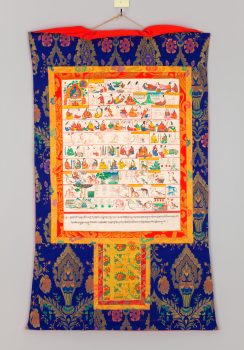Hua Khar
Chentsa, Amdo region, Northeastern Tibet (Jianzha, Qinghai Province, China)
1995-1996


Hua Khar
Chentsa, Amdo region, Northeastern Tibet (Jianzha, Qinghai Province, China)
1995-1996


This painting illustrates several elements of pulse diagnosis. It first shows certain actions that should be avoided for at least one, but ideally up to three days in advance of the reading, including sexual activities and consuming strong foods and drinks, such as coffee, strong tea, and alcohol. It then outlines that the ideal time for pulse reading is early in the morning before the patient has moved much, although in practice experienced physicians can accurately read the pulse at any time. Another topic explored in the painting is the process of pulse taking. The first step is to determine the “gender” of the pulse, which refers to the thickness of the radial artery and is irrespective of the gender of the patient. The second is to find out whether the patient’s pulse is hot or cold in character, a distinction based on the rate of the pulse. The third is to identify up to three of a total of forty-two pulse characteristics, among them floating, empty, halting, rapid, full, taught, sunken, weak, slow, slippery, and soft. Combinations of these characteristics correlate to every condition recorded in Tibetan medical literature. In the fourth and last step the doctor reads the specific pulses of the patient’s organs to assess their condition and the influences of the wind, bile, and phlegm forces and physical injury.
While the primary religious goal for followers of Buddhism is enlightenment, many of the practices also serve secular goals related to daily life, including ethical conduct and cultivating well-being.
Teachings and precepts that offer practical and experiential guidance. In Buddhism instruction is primarily an oral tradition and is often targeted to the specific needs or disposition of a student or disciple.
The passing down of authentic Buddhist teachings from a teacher to a disciple or student, often in the form of a text in a ritualistic context.
Today, Tibetans primarily inhabit the Tibetan Plateau, situated between the Himalayan mountain range and the Indian subcontinent to the west, Chinese cultural regions to the east, and Mongolian cultural regions to the northeast. During the 7th to 9th century, Tibetan rulers expanded their empire across Central Asia, and established Buddhism as the state religion.
Get the latest news and stories from the Rubin, plus occasional information on how to support our work.